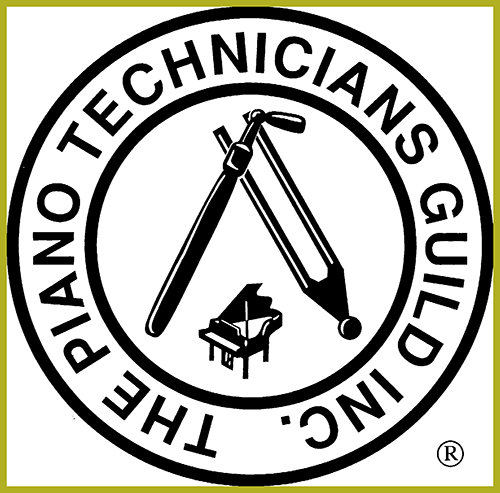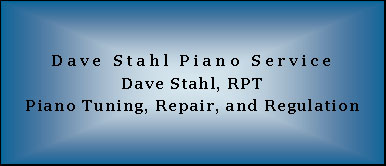
All pianos need periodic maintenance. Depending on the brand and type, the climatic/environmental conditions, as well as the frequency and intensity of play, service intervals will vary greatly.
The three important areas of piano maintenance are the following:
Tuning
Tuning your piano is the area that will need to be most frequently addressed by your technician, consists of adjusting the tension of the strings to standard pitch--A 4, the A above middle C, set to 440 hertz,or cycles, per second. Hearing music at this pitch is important for your child’s developing ear.New pianos need to be tuned more frequently than older ones. Strings may be still stretching. Wood components are still adjusting to the relative humidity in your home. Tuning can change dramatically in a period of time due to climatic changes. Most manufacturers recommend tuning 3-4 times in the first year. Though our climate in the San Francisco Bay Area is a bit more hospitable than most, it should be tuned no less than twice a year for the first 2-3 years in order to maintain and stabilize at standard pitch.
Older pianos are usually more able to hold tune and pitch for longer periods of time: if played frequently or in an environment with a changing climate, at least once a year is the normal recommendation. Letting it go for more than three years without attention is never a good idea. When an old instrument drops well below A440, there can be problems associated with pitch adjustment. Squeaks, clicks, clunks, buzzes, rattles and other annoying noises that can be a detriment to your playing enjoyment may develop over time. If you are diligent about upkeep, many technicians will deal with these at your regular service call. Read more here: Piano Tuning
Back to TopRegulation
becomes necessary when felt and leather parts in the action have become compressed or changed shape from wear. The action is all moving parts inside a piano. An action contains thousands of moving parts. For a piano to operate at optimum efficiency, each of these parts must be checked and adjusted occasionally. The harder and more frequently an instrument is played, the more often it will benefit from some regulation.
Action regulation consists of checking and adjusting each moving part to ensure that it functions properly. When this is properly done, the keys all have a similar feel and response. The goal is to allow the player to have the most control and power possible, and thus, the widest range of expression permitted by the instrument.
Problems such as non-repeating notes*, hammers bouncing or blocking against strings**, and an assortment of other annoyances that might lead one to think that there is something “broken” in the piano are more likely to be regulation issues. Read more here: Regulation
*Notes that don’t repeat quickly can be caused by poorly regulated jacks or backchecks.
**Hammers bouncing or blocking against string are usually a result of the jack being released from the knuckle when the hammer is too close to the string.
Back to TopVoicing
deals with tone. What is “good” tone? That is up to the player. Some like a bright, lively sound, while others prefer a mellow, and darker sound. Regardless of your tonal preference, a musician should be able to play soft passages with delicacy, and loud passages with brilliance and power—within the limits of the instrument. In order to be properly voiced, a piano needs to be well regulated and tuned. It can be a matter of going through all of the hammers to soften or brighten the tone. Often, it’s just evening out the tone by voicing a few hammers or sections of hammers that are overly bright. Sometimes a well-placed carpet, or change of position can benefit the tone greatly.
Voicing is quite possibly the least understood aspect of piano technology that a piano owner will be exposed to. Simply put, it deals with the tone of the piano. Not the tuning, which addresses the pitch by setting the strings to the correct tension. Not regulation, which has to do with adjusting the mechanical workings of the piano. Read more here: Voicing.
This is just a brief outline of piano maintenance. If you would like more detailed information about specific functions, please visit the links or feel free to contact me.
Back to TopThe Weather and Your Piano
The weather affects your piano in many ways. Excess humidity can make a piano go out of tune by causing slight to expansion of the soundboard across the grain, which will lift the bridges and very slightly tighten the strings causing the pitch to go sharp. This is most obvious in the center of the piano, where the soundboard’s rise is most dramatic.
Ridges may appear along the grain of the soundboard where the large spruce panels are glued together. Moisture can creep into the felt key and flange bushings. The moisture content of the keys will change during wet seasons. These things can cause sluggish action or key symptoms. A piano can become unresponsive because hammers and keys don’t return to position rapidly enough for good repetition of notes. Dynamic range becomes limited.
Conversely, dry weather—especially hot dry weather—will cause contraction of the soundboard and lowering of the piano’s overall pitch. If there are cracks in the board, they will probably widen and become more visible.* Any tendency to have buzzing, rattling, or other related sounds will be exacerbated.
Overly dry conditions can make tuning pins loose in their holes. If proper steps aren’t taken, and the climate within the piano—or room where it sits—is not controlled, a piano can eventually be rendered untunable.
Key bushings contract, creating excess side-to-side key movement. Actions become loose as flange bushings shrink. A noisy action and keyboard that feels uncontrollable is a by-product.
The San Francisco Bay Area is, for the most part, hospitable to our favorite instrument. The ideal relative humidity level (RH) for pianos is 42%. The range here is from 40-60 percent most of the year. In-piano climate control is recommended in some of the damper coastal areas, or in the hills where redwoods keep the temperature low and humidity levels fairly high.
*While it might seem a very severe problem, pianos with cracks in their soundboards can be repaired, if necessary. Many pianos have less-than-perfect boards, yet produce beautiful tone with few or no noticeable negative effects.
Back to Top
